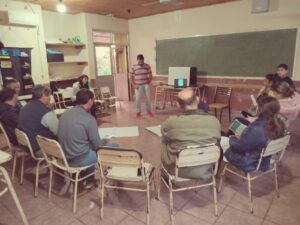Financial Technologies for a More Sustainable Planet
Could these technologies, associated with concepts like observation, information, context and trust, be the tools we need to build a more sustainable and equitable world?
If you have heard of the Internet of Things, big data, artificial intelligence and blockchain, then you have probably heard of “fintech.” These financial technologies are used across consumer and industrial spaces and are now being embraced by financial organizations with large global investments.
Each technology has marked a milestone in the “data revolution”—changing the way we interact with the digital world. At the core of the fintech revolution is the way institutions are using data to make better decisions, enable client understanding and forecast trends at different scales in space and time.
In parallel with the data and fintech revolutions are ongoing efforts at national, regional and global levels to reach the Sustainable Development Goals (SDGs).
The SDGs represent the most important and challenging problems of the 21st century—problems so complex that they require a clear understanding of people and their environment over large areas to solve. A more sustainable world may be possible if fintech developments could be adapted to support social and environmental priorities alongside economic capital.
Four technology families are at the core of fintech: the IoT, big data, AI and blockchain. We see them as key pieces of a digital information pathway. Each respectively represents data acquisition, storage and curation, trust and accountability, and insight and analysis.
The Internet of Things refers to data derived from the rapidly expanding number of Internet-connected devices, from smartphones to weather stations to toasters.
Both wireless and wired, serious and frivolous, the IoT is the thousands of Internet-capable devices that can actively transmit our thoughts, photos and locations or passively monitor countless human and environmental parameters in wide networks. Developments in Wi-Fi, cellular and satellite Internet connectivity allow for remote sensing of human and natural systems.
The IoT is rapidly becoming a major source of big data, especially when users are voluntarily contributing information or providing data that helps them and others make better decisions
The torrent of data that flows from the IoT results in large digital datasets. This is big data.
Big data is essentially any dataset that is sufficiently complex to handle, requiring extra expertise beyond traditional analysis. An infographic developed by IBM breaks it into dimensions: big data is a dataset with high volume (size and storage), high variety (many types of data), fast velocity (frequency of collection) or variable veracity (confidence). Sometimes a fifth dimension, value (specific use and application), is used, which is especially relevant for personal, private or sensitive data like healthcare records or traditional ecological knowledge.
This model emphasizes that size is no longer the only difficulty of Big Data and that some of the value of these datasets may be derived from how complex they are. As technology has progressed, the volume of a dataset has become more manageable with low-cost cloud storage and CPU and GPU speed increases, though highly variable datasets can be analyzed on shorter time frames.
Use, however, requires the difficult work of organization, standardization and curation so that the data can be quickly and cheaply used. In environmental contexts, this means opening the data on a public server with permissive license terms. Even organized big data may be too complex for conventional statistics.
Fortunately, one new technology may help us turn big datasets into action: artificial intelligence.
Derived from computing and statistics, AI uses machine learning from big data to “learn” how to accomplish tasks, whether recognizing patterns, producing human-like chatbots or driving vehicles. In simpler forms, it has been used for years to detect credit card fraud or recognize faces in social media posts. AI excels at recognizing context where simple threshold-based algorithms failed. The statistical heft behind AI can be appropriate. Adding human-like pattern finding in images, chat logs and complex datasets may help experts manage the flood of data.
These three technologies take us along a chain from the collection of data right through to its analysis. But how do we trust this data and make sure bad actors aren’t compromising data streams while ensuring fairness and equality?
This is where blockchain comes in.
Put simply, blockchain allows for a single piece of digital data to be tracked from its source with an encrypted stream of information that can only be decoded by a distributed peer-to-peer network. Blockchain makes data more trustworthy, to both data providers and users, allowing each to be certain of its provenance and integrity.
So how does all this relate to the SDGs and how can fintech help us achieve the goals? Singular advances have propelled technology, but—like the Internet—the confluence of many related technologies can dramatically change how we think about the world.
However, many organizations are still struggling with 20th-century information technology problems such as organizing data collection and curation, developing standards and practices, and visualizing the state of the environment. Leveraging the wisdom of financial industry leaders can help us improve the collection, interpretation and accuracy of data collection—all of which are essential to turning information into knowledge—and then turning that knowledge into sound and robust decisions.
Source: International Institute for Sustainable Development (IISD)
Alecrin annualreport biodiversity BiodiversityDay carbon credits carbon footprint comunidades locales Consulta Pública Cooperativa Nueva Esperanza CPSI program cruce caballero ECOLOGY ecosystems ENVIRONMENT environmental education environment crisis ESG Criteria FORESTS gaia global warming green cross uk gs1 reserve gs1reserve Highlights localcommunity Metodología de investigación social native species natural disasters nature news Patagonia reforestation regeneration Relaciones con la comunidad reserva GS1 Responsabilidad social SDGs STATE OF EMERGENCY stockholm+50 sustainable investment UN UNEP voluntary carbon market woods on fire youth






